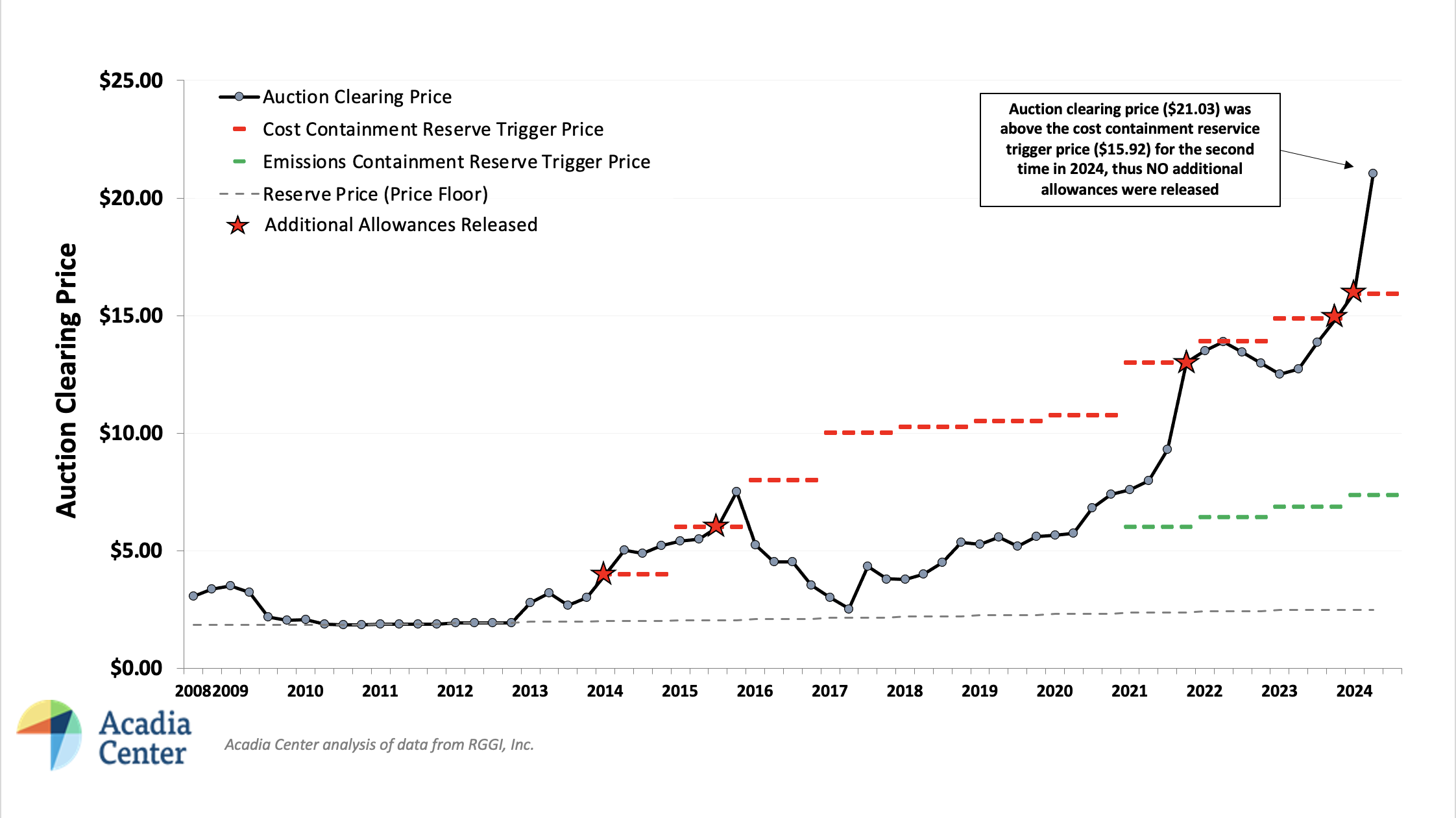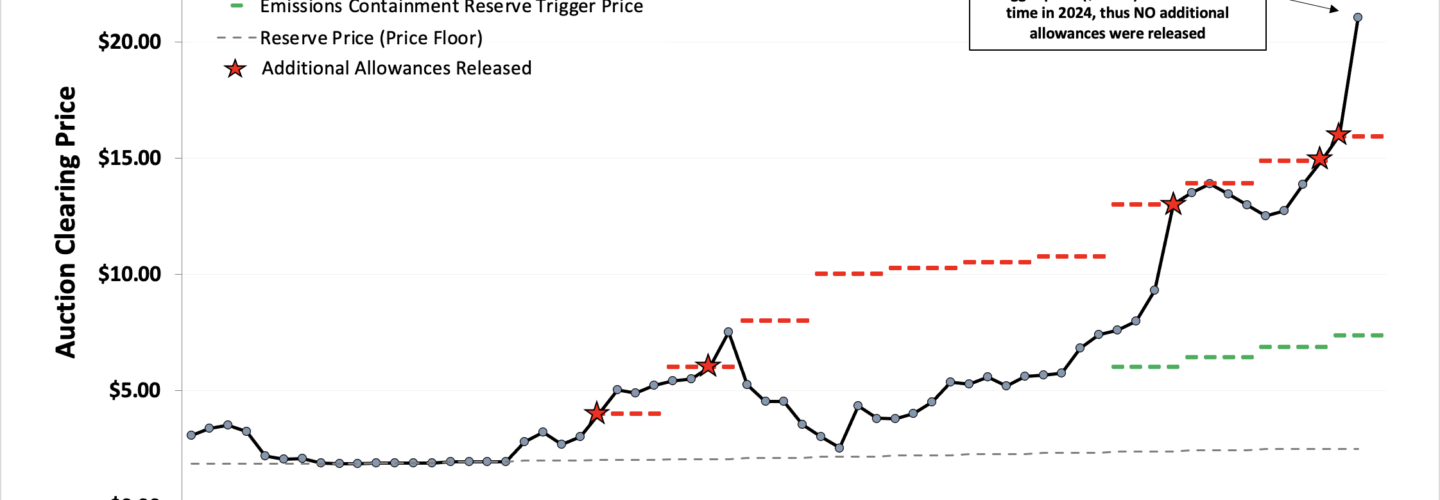RGGI 64th Auction: An Additional $337 Million Raised for Clean Energy
BOSTON, MA – On Wednesday, June 5, 2024, the ten states participating in the Regional Greenhouse Gas Initiative (RGGI) released the results of the 64th auction 2024. Emissions allowances were sold for $21.03 each, generating $337 million for clean energy investments in participating states.

“The record-setting price in the 64th RGGI auction speaks volumes, it’s a reflection of the growing value in the collective effort to reduce carbon emissions —$337 million raised brings RGGI’s cumulative total to a staggering $7.8 billion since the inception of the program, and these newly generated funds will continue to invest in sustainable solutions and support the transition to a cleaner, more equitable energy future,” stated Paola Tamayo, Policy Analyst at Acadia Center and co-author of the organization’s RGGI Third Program Review Report.
The allowance price of $21.03 is the highest price observed historically since the RGGI program’s inception. RGGI auctions stand as a crucial mechanism for curbing carbon emissions and charging power plants for their climate pollution. Among the various instruments within RGGI auctions, the Cost Containment Reserve (“CCR”) – a market mechanism that releases extra allowances beyond the cap to be sold if prices exceed predetermined levels – was triggered for the second time in 2024. Since the CCR was triggered during the 63rd auction, all the CCR allowances for the 2024 calendar year have been released, so despite the 64th auction price meeting the threshold for triggering the CCR, there were no additional allowances released.
The CCR was initially conceived to be a safeguard, only to be triggered in times of extraordinary circumstances. Recent trends have shown a worrisome pattern: in the latest auction, the CCR was triggered for the third consecutive time. This pattern highlights the importance of reassessing the CRR trigger price in this Program Review. By raising the CCR cost, more breathing room is created for auction prices to rise, ensuring the effectiveness of the RGGI cap in reducing emissions.
Furthermore, the Emissions Containment Reserve (ECR) retains allowances for additional emissions reductions if prices fall below the trigger price of $7.35 in 2024. Notably, the ECR remains well below the auction price and has historically not been triggered. That means that the auction price is almost three times higher than the trigger price, signaling a significant deviation from the original intent of this program mechanism. For the ECR to maintain its effectiveness as a market stabilizer, it should show a more dynamic response to fluctuations in auction prices. While the ECR serves as a vital safety net, its rigid structure makes the effect of this mechanism negligible in the face of rising auction prices. As stakeholders engage in discussions surrounding the third program review, there’s a pressing need to reevaluate the mechanisms governing the ECR. By introducing greater flexibility and adaptability into its design, the ECR can better fulfill its role in ensuring the stability and integrity of the RGGI market, ultimately driving progress towards a more sustainable future.
Higher RGGI allowance price is good for climate, clean energy investment
The clearing price of $21.03 for the first auction of 2024 marks a continuation of the upward trend observed in recent years. This clearing price represents a 65% increase from the clearing price in Q2 of 2023 and a 31% increase from the last auction. The positive trajectory witnessed in the 2023 and 2024 auctions holds promising implications for the RGGI program. Higher observed allowance means that the RGGI program is sending a stronger incentive to reduce fossil fuel emissions and produce electricity from carbon-free sources, like wind and solar.
Since the program launched, the vast majority of RGGI proceeds have been invested in energy efficiency and clean energy projects, as detailed in the most recent report on RGGI investments in 2021, released in June of last year. We are also hoping for a more timely and transparent reporting system on proceeds investments. As the auctions generate significant revenue, it’s crucial to ensure that these funds are allocated efficiently and effectively towards clean energy and energy efficiency initiatives.
The $337.5 million in proceeds generated in this auction brings the cumulative to-date total to $7.89 billion. The 2023 and 2024 auction results underscore RGGI’s significance as more than a regulatory framework, emphasizing its influence on the shift towards sustainable energy. RGGI states show the practicality of a collaborative, market-driven strategy for reducing greenhouse gas emissions.
RGGI Third Program Review Offers an Opportunity to Direct Proceeds Towards Clean Energy Investments that Directly Benefit Environmental Justice Communities
Since its establishment, RGGI’s priorities have centered around reducing pollution from fossil fuel power plants and achieving climate solutions for RGGI states. Every five years or so, RGGI undergoes a program review, giving the participating states the opportunity to consider the program’s performance and make various changes, including the equitable disbursement of the program’s proceeds. RGGI’s Third Program Review is happening now, and we are still waiting for more information on what to expect from them this year. Especially since it was expected to conclude at the end of last year. In 2023, RGGI held two public meetings and two public comment periods to discuss and seek feedback on various aspects of the program. Acadia Center, other stakeholders, and the public at large await any responses from the states to public input on setting the cap and improving overall program design and operation.
As discussed in more detail in Acadia Center’s most recent RGGI Report, there are many different ways in which RGGI can ensure that environmental justice communities are heard and are actively involved in the development of strategies for an equitable transition to a carbon-free economy. Regardless of how strongly the Third Program Review does or does not prioritize environmental justice, it should remain a priority for individual states to consider the recent auctions, the history of investments across the states, the need to benefit environmental justice communities directly, and other mechanisms associated with the cap-and-invest program.
Acadia Center remains closely involved in RGGI policy conversations across the RGGI states and will continue to advocate for program reforms that drive equitable investment and climate action.
Media Contacts:
Paola Moncada Tamayo, Policy Analyst
ptamayo@acadiacenter.org, 860-246-7121 x204
Ben Butterworth, Director: Climate, Energy, and Equity Analysis
bbutterworth@acadiacenter.org, 617-742-0054 x111




















Follow us